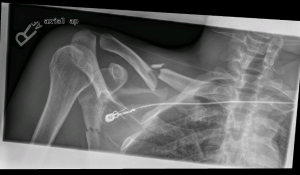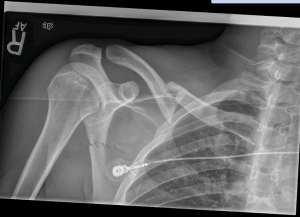Here are the images again:
There is a right middle third clavicle fracture and right scapula fracture!
Scapula Fractures:
- Relatively uncommon
- Many associated injuries, which can be LIFE-THREATENING: hemothorax, pneumothorax, pulmonary contusion, humeral fractures, skull fractures, or splenic injury
- Treatment: REMEMBER to treat life-threatening injuries FIRST! Scapula treatment: short-term immobilization with sling.
Clavicle Fractures
Background
Because of its position, the clavicle can be fracture easily. Most common mechanism: fall directly onto the lateral shoulder. These fractures are divided into groups:
Group I (middle third): ~80%
- Occurs medial to coracoclavicular ligament
- Displaced upward because of the pull of the sternocleidomastoid muscle
- Mechanism: direct force to the lateral shoulder from fall, sporting injury, or MVA
Group II (distal third): 15%
- Occurs lateral to the coracoclavicular ligament
- Mechanism: direct blow from the top of the shoulder
Group III (medial third): 5%
- Mechanism: direct blow to the anterior chest
- Injuries to this area are accompanied by other serious injuries – tremendous force is needed to cause this type of fracture
Physical Exam
Perform a neurovascular exam
- Possible brachial plexus injury
- Decrease pulses can indicate subclavian artery injury
- Venous stasis or discoloration or swelling can indicate a subclavian venous injury
Pulmonary injury:
- Diminished breath sounds can indicate a pneumothorax
Concomitant injury:
- Scapula injury
- Ribs injury
Workup
Xray
- These will be able to delineate fracture and displacement
- Consider obtaining chest xray if suspicious of pneumothorax or other lung injury such as hemothorax
- Consider rib xray if suspicious of rib injury
CT
- To further evaluate displaced fractures
- In medial clavicle fractures: can show posterior displacement of fracture or evaluate for injuries to neurovascular structures
Angiogram
- Only if suspicious of vascular injury
Treatment
Group I fracture:
- Mostly nonoperative – sling or figure-of-eight brace
- Operative if: severely displace or shortened > 2cm; comminuated with displaced transverse z-shaped fragment; neurovascular compromise; open fracture
Group II fracture:
- Surgical repair: because nonunion rate is high
Group II fracture:
- Nonsurgical
- Sling
References:
http://emedicine.medscape.com/article/1263076-overview
http://emedicine.medscape.com/article/92429-overview
The views expressed on this blog are the author's own and do not reflect the views of their employer. Please read our full disclaimer here. Any references to clinical cases refer to patients treated at a virtual hospital, Janus General Hospital.
The following two tabs change content below.


jwang
Latest posts by jwang (see all)
- Xray Vision Answer - May 24, 2015
- Xray Vision: My Arm Looks Funny…. - May 16, 2015
- Xray Vision: Limping Answer - April 27, 2015
- Xray Vision: Limping - April 17, 2015
- Xray Vision: Answer - March 27, 2015


